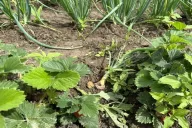Who are glassworms and how to deal with them: many underestimate this pest
When talking about pests, the first to come to mind are the Colorado potato beetle and the mole cricket, then the wireworm and the weevil. Of the moths, summer residents have trouble with cabbage whites.
There is another representative of Lepidoptera that we should not forget about. But few people know what the insect looks like.
Who is a glass woman?
There are several species. Butterflies have transparent wings, which makes them partly related to flies, partly to wasps. Everyone who grows currants is familiar with this parasite. But besides the currant glasswing, there are other, less known species.
Apple glassworm - its larvae live under the bark, make passages in the tree, and gnaw out the core of young branches. This insect has a dark abdomen and a red belt. It poses a threat to pome and stone fruit trees.
Raspberry glassworm - similar to a wasp, can also damage rose bushes and blackberry plantings.

In addition, glasswings live in poplars, birches, willows and, regardless of their species, cause serious harm to gardeners, laying from 50 to 200 eggs.
How to deal with glassworm
The problem is that the insects start flying at the same time as the main garden crops start blooming. Because of this, the use of pesticides is postponed. The females lay eggs so skillfully that it is almost impossible to detect the clutch, and a special shell protects the offspring from pesticides. After the larvae get into the wood, nothing is scary for them.
1. Prevention. There is no way around it. In the spring, all damaged shoots and branches must be cut out, and the cuts must be treated.
2. The smells of wormwood, tansy, citrus, onion and garlic peels, as well as tar soap, repel pests.
Decorative ones include nasturtiums and chrysanthemums, aromatic ones include mint and lemon balm, sage and calendula.
3. You can make traps yourself. They are hung on bushes and tree branches. These can be any containers with fermented jam and vegetable oil - so that insects stick, flying to the smell.
It is also necessary to monitor the trees and promptly remove all suspicious and drying branches. It is necessary to inspect the cut part, and if a core damaged by a pest is found, the shoot is cut to a healthy base.
